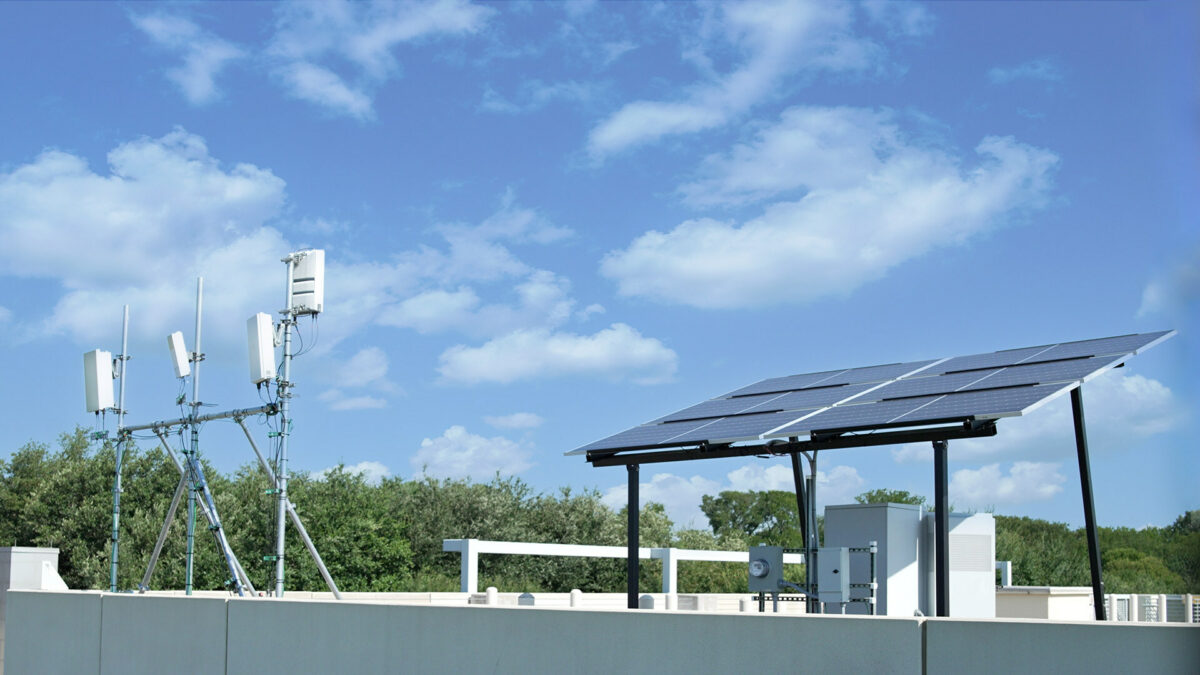Telecommunications company Ericsson turned a new page in its sustainability book after debuting the first phase of a telecom tower microgrid, which uses a 2.4 kW solar array plus 14.4 kWh battery storage at a 5G center in Plano, Texas.
An Ericsson spokeswoman told pv magazine USA that the company is using six bifacial 400 W solar panels assembled with three company-supplied lithium-ion battery packs on a corporate facility rooftop. Using ample eight to nine hours of north Texas sunlight, the site is capable of operating off-grid for up to 24 hours, she said.
The 5G site includes an ultra-lightweight mid-band Massive MIMO AIR 6419, RAN Processor 6651, which transmit high-speed wireless phone services, along with an enclosure which comprises the company’s Solar shelf 6670 paired with lithium-ion Batteries 6612, and energy management controller 6610 for hybrid energy operation.
“Ericsson’s smart site solutions for hybrid energy sources are designed to help operators control costs and increase profitability – especially in rural or remote areas or private networks, where traffic volumes are lower and power consumption needs to be especially efficient,” said Ed Gubbins, principal analyst at Global Data. “Using a variety of tools to increase energy efficiency and sustainability – including solar power, lithium-ion batteries, and advanced software features – can be helpful for improving operator profitability.”
Additional features of the telecom microgrid include load shifting, peak shaving, and demand response, which enables the site to effectively utilize batteries when electricity rates are high and recharge the batteries when electricity rates are lower. This power dynamic strategy allows for multiple daily cycles, ensuring optimal cost efficiency by taking advantage of the most favorable electricity prices.
The second phase of the Plano, Texas 5G project will involve deploying additional clean energy resources, such as hydrogen-based generators, as an alternative to on-site diesel generators. It will also explore interoperability with power grid vendors, using other local energy generation and consumption to sell back to the grid with net metering.
Network operators under the Ericsson Network Manager framework can utilize the Plano site’s policy-based Battery Saver, where the users can switch off specified radio frequencies to reduce daily energy consumption and meanwhile increasing network resiliency.
The Plano telecom microgrid has the potential to serve as a demonstration for trial radio hardware and software solutions that improve energy efficiency in conjunction with smart-site solutions. The project could be used by utility companies in areas such as grid frequency, voltage regulation, and demand response energy trading.
Ericsson debuted the Texas microgrid with a three-minute video clip overview of the facility:
In 2022, Ericsson’s Net Zero report titled “Breaking the Energy Curve” detailed plans for the expansion of distributed energy solutions such as solar and energy storage systems to offset energy costs and reduce operating expenses of high density networking operations such as in Plano, Texas. The multinational company has set a goal of its operations becoming net zero by 2040, with the first step of reducing 50% of emissions across its network upgrading to 5G by 2030. The company’s research shows global mobile networks use 0.6% of global electricity usage.
This content is protected by copyright and may not be reused. If you want to cooperate with us and would like to reuse some of our content, please contact: editors@pv-magazine.com.









Absolutely fantastic news! The Ericsson solar-plus-storage microgrid powering the Texas 5G station is a true testament to the potential of renewable energy in transforming our technological landscape. This initiative not only showcases innovation in sustainable power solutions but also highlights the commitment towards a greener and more resilient future. It’s heartening to see such partnerships making a positive impact by providing reliable and clean energy to critical infrastructure like 5G stations. Kudos to Ericsson for taking a bold step towards a cleaner and more connected tomorrow!